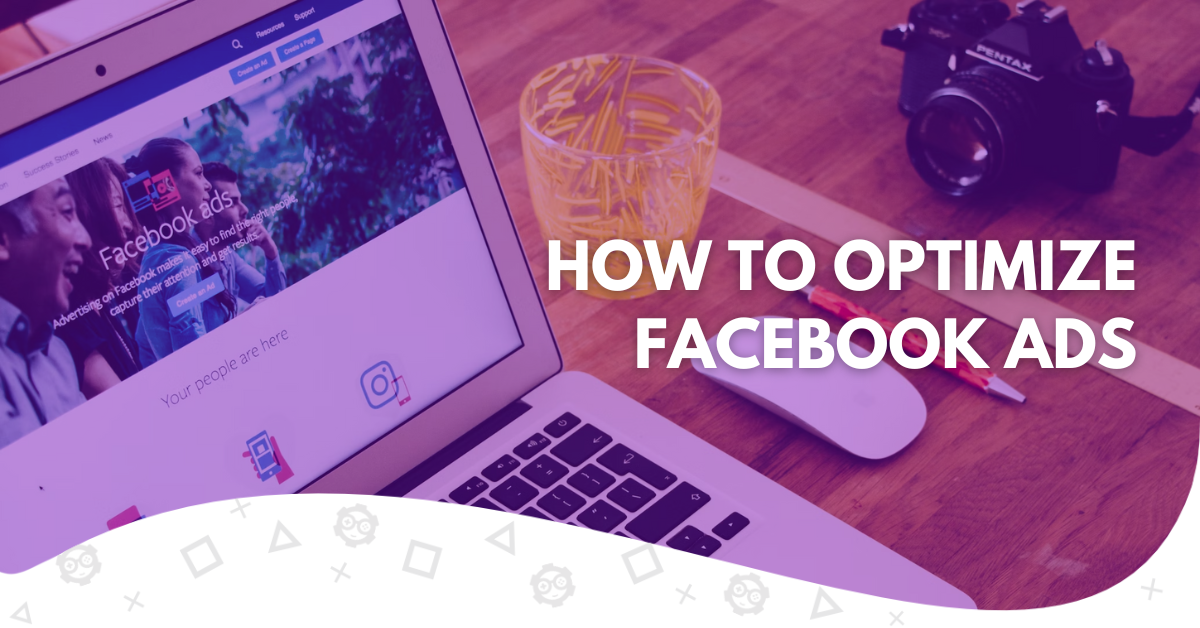In the unsteady modern world, advertising possibilities abound in almost every media and platform we can access from our computers and mobile devices. Advertisements range from inquiries in search engines to social media publications, reaching thousands of users per day. These circumstances are great for advertisers, retailers, and marketers looking to position their products and services in the best online ad placements.
One of these top ad placements is Facebook, which boasts over 3 billion users.
Consequently, Facebook Ads have a primordial place in the advertising struggle to get the most attention from potential customers.
In this helpful post, we’re giving you some strategies on How to Optimize Facebook Ads you can adopt to improve the results of your advertisements and increase your revenue and brand awareness significantly.
What Are Facebook Ads?
Facebook ads are advertisements shown on Facebook or Meta’s platforms through different creatives, like banners, static images, videos, reels, and more.
Facebook Ads Manager, Meta’s platform through which you control the ad delivery, puts at your disposal multiple simple self-serve tools that facilitate you to build your campaign and get easy-to-read reports.
Most Facebook ads appear in the feed on desktops, mobile devices, and in the right column of Facebook on desktops. These ads are paired with actions that customers take inside the platform and other external factors, telling Facebook which are the purchasing behaviors.
What Are the Benefits of Implementing Facebook Ad Campaigns?
Publishing advertisements on Facebook benefits especially startups and small and middle-size businesses that need to increase their awareness and sales. Below, we explain five additional benefits resulting from running ads.
- It Allows You to Reach Customers Across a Wide Range of Devices
Facebook is one of the largest platforms worldwide; over 1 billion people use it on desktop or mobile devices daily. It means you can reach users across all devices by creating specialized and responsive ads that ensure the best experience for the user.
- It Provides You with Better Control Over Your Ads with Advertiser Controls
Facebook Ads provides brand safety and suitable controls for any Facebook business that wants to prevent its ads from running alongside no-desired content on the Meta Audience Network. Some controls are the following:
- Manual placements. You can directly control where your ads appear on Facebook, Instagram, Messenger, etc., opting for specific placements.
- Inventory filter. The inventory filter gives you even more control over sensitive content, allowing you to select the content your ad appears within. It applies to the Facebook Feed, Instagram mobile feed, Ads on Facebook reels, Facebook in-stream videos, and Ads on Instagram reels.
- Block lists. Facebook Ads allows you to upload a list of URLs where you don’t want your ads to appear.
- Topic exclusions for in-stream videos. You can exclude certain topics and choose which in-stream videos you want your ads to display. You can choose exclusions from four topics: Politics, News, Gaming, and Religious.
- Publisher lists. Facebook Ads platform provides you with a list of URLs where Facebook could place your ads. You can download the list and copy and paste the URL you’re interested in into the publisher list.
- Deliver reports. It provides a document with impression-level data at the content and publisher level, giving transparency into which content your ad appears.
- It Facilitates you to Engage with Clients with Advantage+
Facebook Ads allows you to reach your business goals by engaging with different types of clients and levels of the funnel. With Advantage+, your more relevant ads will run where they will most likely reach goals. This practice lets you advertise your page, account, website, or channel.
- It Allows You to Market Your Business with Engaging Videos
It supports various video ad types, technologies, and placements to reach your audience with content matching how users spend their time on Facebook. You can create feeds, in-stream videos, and stories to engage as your customers do.
- It Allows you to Control Your Ad Budget Better
Facebook Ads lets you administer your budget most effectively to drive better and more accurate campaign results for your business ads. Facebook advertisers can directly control their money by reaching ideal customers with enough money to deliver the expected results.
How to Optimize Facebook Ads
Taking your advertisements to the next campaign level involves applying the following fourteen strategies related to different objectives. Let’s check them out.
- Create a Facebook Advertising Funnel

Building a functional Facebook advertising funnel that nurtures potential customers throughout the purchasing process is crucial to keeping the interest of website visitors and leads.
Regardless of the type of Facebook ad campaign you’re implementing – for instance, an awareness or traffic campaign – you should address users at different funnel levels. To do this successfully, you should create different ads for different funnel phases with different ad targeting.
For example, if you notice that many users are interested in your products and click your ads, you can address them in the middle of the funnel through a remarketing strategy plan.
- Select the Right Campaign Objective
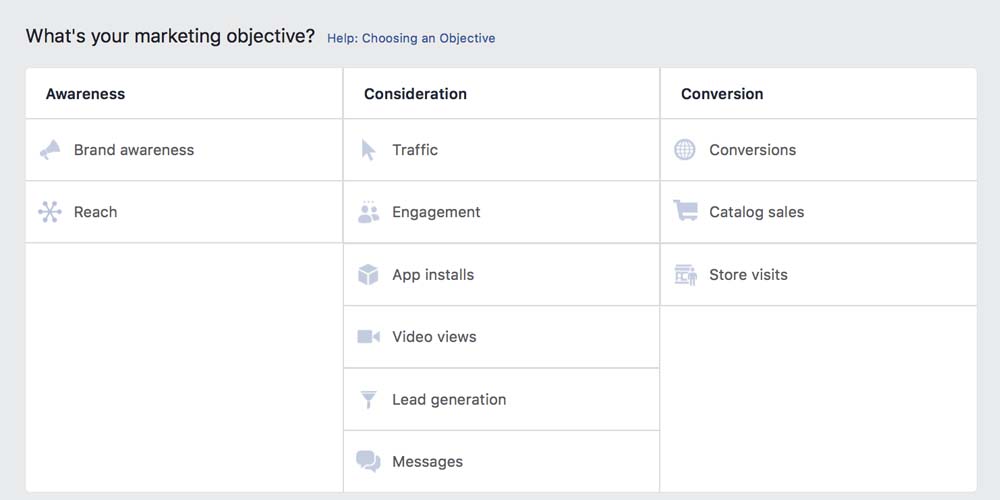
A very beneficial aspect of using Facebook Ad Manager is that it allows you to select the campaign objectives that fit your business purposes easily. As you can see in the image above, there are several phases you should address with your Facebook campaigns. Each phase considers different objectives that convey different types of customers.
When you start a new Facebook ad campaign, you’ll be prompted to select the main campaign objective.
For example, if you’re beginning with your entrepreneurship or have a startup, your objective is to increase brand awareness or reach potential customers. On the other hand, if you have a certain time developing your business and want to generate leads, objectives like “engagement” or “lead generation” are the right approach. Finally, if you want to increase conversions, then objectives of the last phase of the funnel, such as “catalog sales,” are what your business needs.
- Add Unique and Creative Assets
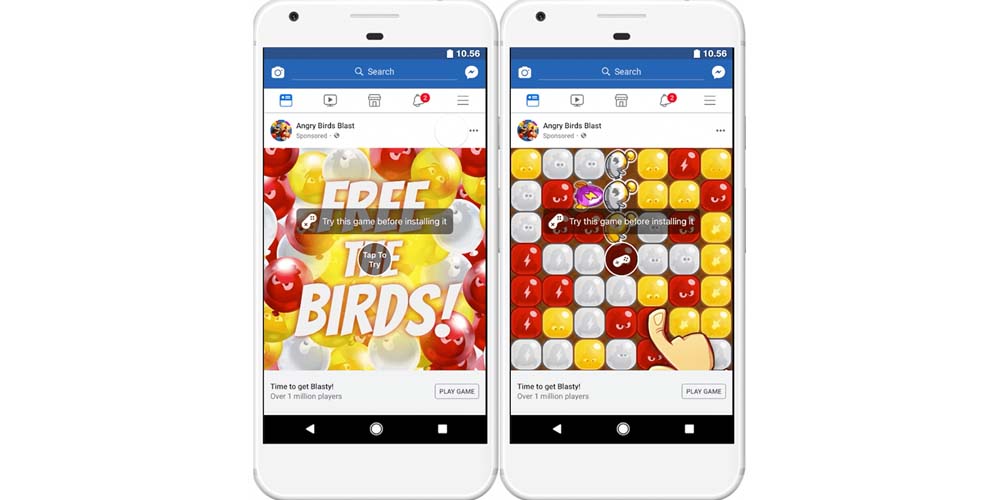
Any successful ad campaign you implement on Facebook is likely designed to last several weeks and months. In other words, it’s thought for the long run and continuously reaches new results, such as leads and conversions.
Sadly, long-term strategies tend to bore customers already in the advertising funnel because marketers and advertisers repeatedly use the same image or message. This is the worst mistake you can make! Fatigue is a common problem in most advertising campaigns, especially when you’re continuously addressing the same target audience.
The best way to avoid this issue is to use different types of assets during the entire campaign and motivate potential customers from different points of view and content.
For instance, if you want to promote a new video game or gaming app, you can create initial video ads to impress potential gamers and appeal to their senses. You can use this strategy for two weeks, maybe one month, and then release recurrent visual ads on the Facebook wall. You can boost this strategy by including creative ads in other media, such as emails.
- Keep Your Landing Page(s) Updated
Facebook ad optimization involves several strategies that can be carried out outside this social media. One of these strategies is to keep the landing page updated.
But what does “to keep updated” actually mean?
The landing page(s) reflect what the ad promotes, using the same language, phrases, images, design, color, and graphic style. Facebook users should feel that the process is continuous and follow a natural path until they complete the purchase.
Besides, when custom audiences arrive at the landing page(s), they should find additional information about the product, mainly benefits, but also features you consider crucial to selling your product.
There are different approaches regarding the appropriate length of landing pages. Some experts believe short landing pages are better for conversion and large ones for brand awareness. Whatever approach you adopt, keep it simple and accelerate the process by including a CTA button.
- Select the Best Bid Strategy for the Campaign
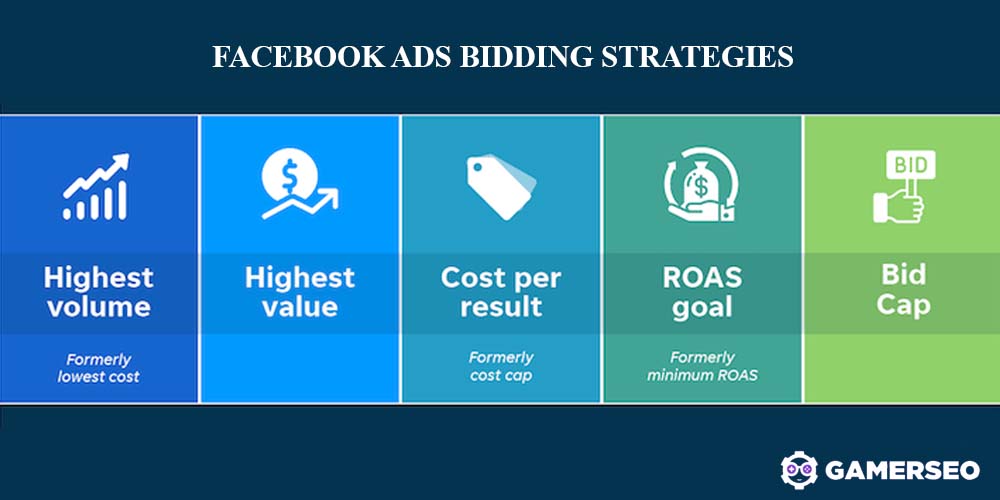
Facebook gives marketers, retailers, and advertisers five main bidding strategies they can adopt according to their business model goals.
- Highest volume (formerly lowest cost). It is a spend-based bidding strategy that seeks the most conversions for your budget. This practice is perfect if you’re interested in quantity rather than quality and do not have specific goals.
- Highest value. A spend-based strategy that seeks to get the highest-value conversions for your budget. This strategy is perfect when you want to spend all your budget and get the best Facebook ad results.
- Cost per Result (formerly cost cap). It is a goal-based strategy focused on getting results at a certain cost per result. Here, you keep your CPA (Cost-per-Action) consistent.
- ROAS goal (formerly minimum ROAS). It’s a goal-based approach to get a certain return on ad spend and maximize results. If you want to break your ad spend, it’s the right approach for your campaign.
- Bid Cap. A manual strategy where you set the maximum bid for your ads. This option is for digital marketing experts with a strong understanding of CVR (Conversion Rate).
Facebook delivers different results according to the bid strategies explained above. You must select the objective that aligns with your main campaign’s objective and target users.
- Select the Top Ad Placements
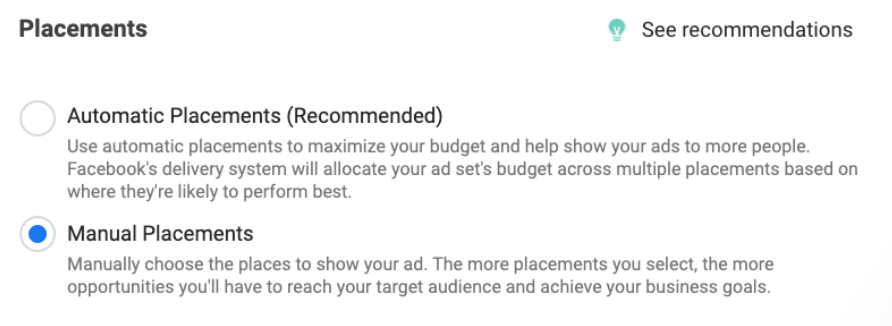
The Meta network has several ad placement options for your advertisements across different platforms, including Facebook, Instagram, and Audience Network. Common ad placements are the following:
- Feeds;
- Stories and reels;
- Search;
- In-stream;
- Messages;
- In-article;
- Apps and sites.
In general, Facebook recommends using automatic placements. In this method, Facebook uses automated rules to define the best placements for your ads across all their platforms. Still, if you choose manual placements, you can select the platforms and the placements where you want your ads to appear.
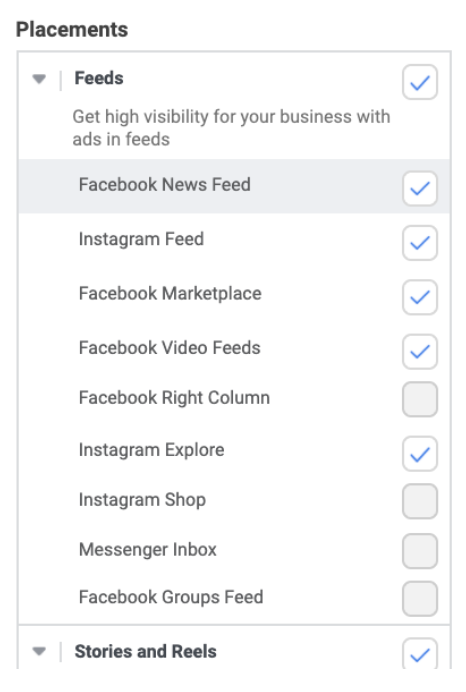
It’s obvious, but you should choose a huge range of placements to increase the likelihood of lookalike audiences. In this section, you can select whether to display desktop or mobile-only ads. If you select your ads to appear on both devices, ensure they are optimized for both sets.
- Find Out the Best Funnel Audiences

Usually, some segments work better than others for different reasons. The idea is to prioritize the best-performing target audiences to strengthen efforts and allocate more budget to these groups. But how do medium and small business owners determine the top marketing funnel audiences?
The first is accessing Facebook Ads Manager and selecting a campaign and a demographic metric like Age, Region, Country, Gender, etcetera, from the breakdowns menu. Once doing this, review segments to find those with the lowest and highest CTR, CPC, and other relevant metrics.
With the insights you get from this operation, you can adjust your bidding strategy and even target audience members who previously weren’t considered in your planning. If you notice that a certain segment has low performance, you can modify the segment and check if the new approach provides better results.
- Use Remarketing with Engaged Audiences
Remarketing is one of those strategies you should adopt when addressing potential customers in the middle of the sales funnel, i.e., customers who interacted with your product or advertisement in the past.
In other words, if your right bidding strategy moves further down the funnel, the correct tactic is to detail even more audiences, which involves their more specific behaviors, endeavors, and purchasing intents. In this sense, retargeting a lookalike audience that previously engaged with your advertisements or content is the most effective approach.
Consequently, it would help if you built retargeting groups to create the right retarget ads according to the data you get from sources like:
- Website visitors who have shown a real purchasing intent and clicked certain pages on your site.
- People who follow your business or publications on your Facebook page or Instagram account or custom audience that has engaged with your products or services.
- Clients subscribed to your ecommerce site newsletter or from your customer relationship management tool.
- Customers that have completed a purchase and show new purchasing intents.
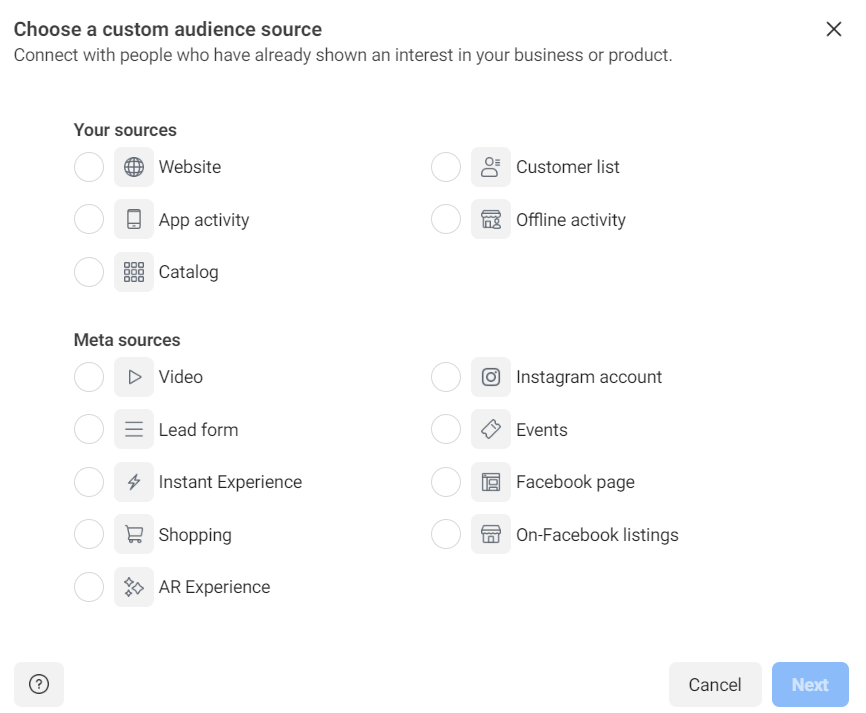
So, it would be best to create a new custom audience for retargeting them according to the sources you see in the image above. Remember that this retargeting strategy can improve your campaign performance by giving the final push to customers close to completing a purchase. Retargeting should work as a parallel strategy to others you can carry out to create awareness or leads.
- Use a Geo-Targeting Approach
To optimize your Facebook ads, it is important to clarify the country, region, or city where you want your Facebook ads to be displayed. This is even more crucial when you have a brick-and-mortar business that intends to attract people from the surroundings, the city, the region, or the country. This way, you ensure that your ads will reach people with real possibilities of completing a purchase or who can visit your store.
Facebook’s geo-targeting option allows you to display ads to people in the specific geographic area you set up.
You can target ads based on:
- Country;
- State;
- Province;
- City;
- Congressional district;
- Radius;
- Zip or postcode.
To create a geo-targeting ad, first, you need to create a new advertisement and set up the target geographic area. If you want to specify even more and narrow the target, you can set up targeting by behavior or demographics. Here, you can increase or decrease the age range to exclude – or include– people you think do not have a chance or interest in purchasing your products. You can even exclude people outside a specific region using an exclusion zip code.
However, if you narrow your criteria too much, Facebook won’t be able to display your dynamic ads because it does not find people who fit your criteria.
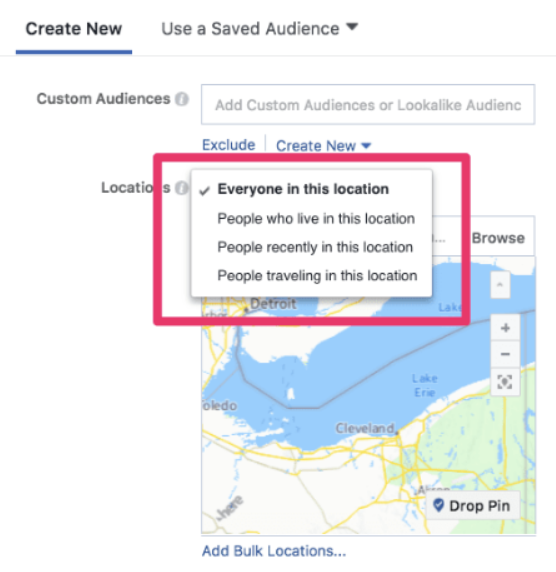
Finally, you can also narrow audiences by targeting specific geographic behavior. It means that not all people in a specific area are there for the same reasons. The options are the following:
- People in this location:
- People who live in this location;
- People recently in this location;
- People that are traveling in this location.
- Exclude Certain Audiences with low Purchasing Intent
We’ve already mentioned some strategies aiming at the same objective –avoiding audiences with low purchasing intent– but you should apply this strategy to all your ads on Meta’s platforms. Besides, once you start getting more conversions –which means you get a larger pool of customers– you must sort audiences and define which are better for further campaigns.
For example, you have a pool of 1,000 customers that completed a purchase in the last month. The next step should be addressing these customers through channels and ad elements, such as email marketing and Facebook ads. This is when you should remarket them, sell them an additional product, or make them subscribe to a service, etcetera.
But how do I separate actual audiences?
The first move is to exclude segments that do not have a high ad frequency. It means people who click an ad only once in a while. You should exclude this segment and put your efforts in the right audience.
The second move you should do is to exclude existing customers that do not provide enough value to your campaign. We mean customers with low purchasing power or those who take a long time to purchase a product, whether it is a small product or not. The problem with these customers is that they mean high advertising costs with low returns.
For more excluding options, click the Exclude button inside Ad Manager under Detailed Targeting. Here, you can separate a particular lookalike audience based on your criteria.
Focus your efforts on potential high-value customers from which you can get wide views, interactions, and conversions.
- Focus on Conversion Events
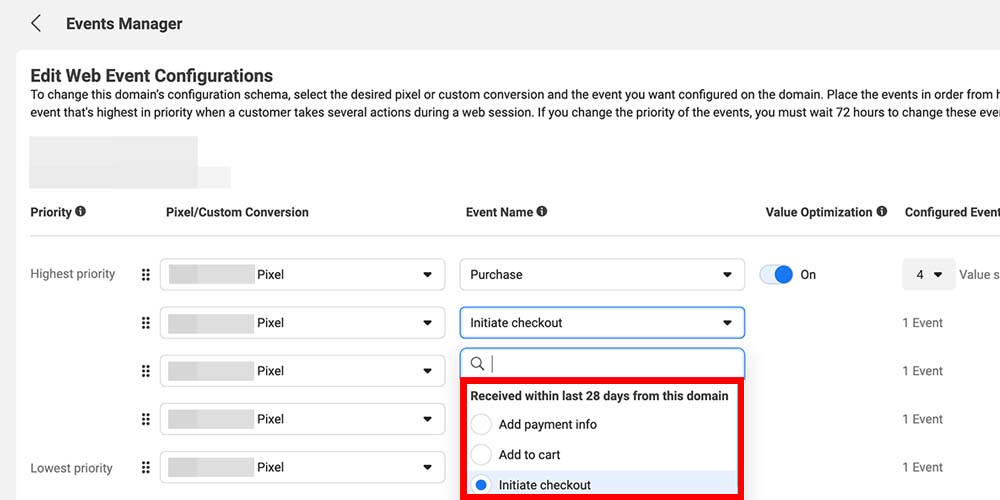
Before delving into this optimizing strategy, mentioning a conversion event is necessary. Facebook events are landmarks through which you track user actions on a website. Facebook shares this data through conversion APIs and Facebook Pixel.
Conversion events allow you to analyze the behavior of the users visiting your Facebook profile and landing page and show your ads to people most interested in them. Focusing on conversion events will help you to receive accurate results from your conversion and remarketing campaigns.
Installing Facebook Pixel –Meta Pixel – on your website to do this. After this, locate Pixel in Facebook Events Manager and head to the Aggregated Event Measurement tab. In this tab, you can configure your events. Add conversion events you want to target in advertisement campaigns through the dropdown menu. Sort them according to their priority.
- Run A/B Tests with Ads Manager
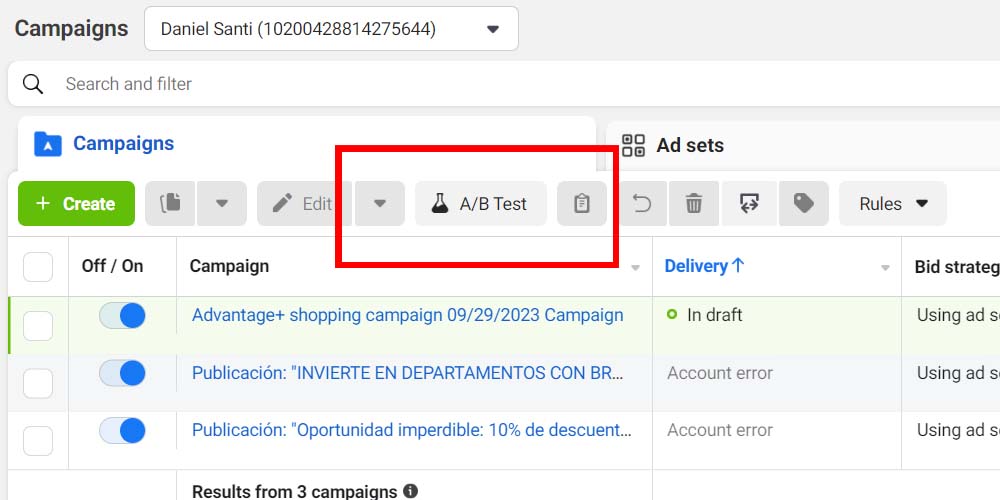
Any campaign you run through Facebook Ads should be tested to check if it works as expected. This way, you can always know which ad to optimize and how to do it. With the Experiments tool within Facebook Ads, you can run A/B tests to assess the existing content you’ve created and whether it needs a new approach.
An A/b test involves changing a variable in ad sets that look similar to each other to evaluate the customer’s behavior toward the two versions. You can run an A/B test in different strategies such as ad placement, creative, specific audience, or ad types.
In this context, you should choose a relevant key metric, or KPI, to measure how the subtle difference affects the customers’ actions. For example, if your ultimate goal is getting more visitors to your landing page, then measuring the click-through rate should be the proper focus for evaluating this.
Once you finish the split, AKA A/B test, you will have enough data to modify the ads or apply to new audience segments. You can also use the data gathered to change bidding methods in further campaigns.
- Scale Your Campaigns with Automated Rules
Like many marketers, you may have multiple versions of the same ads, all giving good results. Once you understand how to get results reliably, it’s a good time to scale your campaigns. There are several ways to scale Facebook ad campaigns:
- Increase your budget. This scale method corresponds to the most basic strategy, but increasing the budget means you allocate more money to place more ads or increase the campaign’s length.
- Scale lookalike audiences. A lookalike audience is a mirror of an existing audience. If you create a lookalike audience with 10% of your existing customers, you will have a new and closer audience to your goals.
- Create a funnel with ToFu offers. This strategy applies to entice customers or businesses, especially B2B businesses, by offering product advantages or free versions. This way, you can thicken the incoming buyers.

Source: Techtarget.
- Use dark posts. These posts refer to unpublished posts you can use through several campaigns. These use the same ID and create a viral effect that helps you increase the effect of your ads.
- Use Instagram story interactive poll ads. You can enter questions and answers, adjust the poll size, and define where the ad will appear in the Interactive poll ads on Instagram Stories.
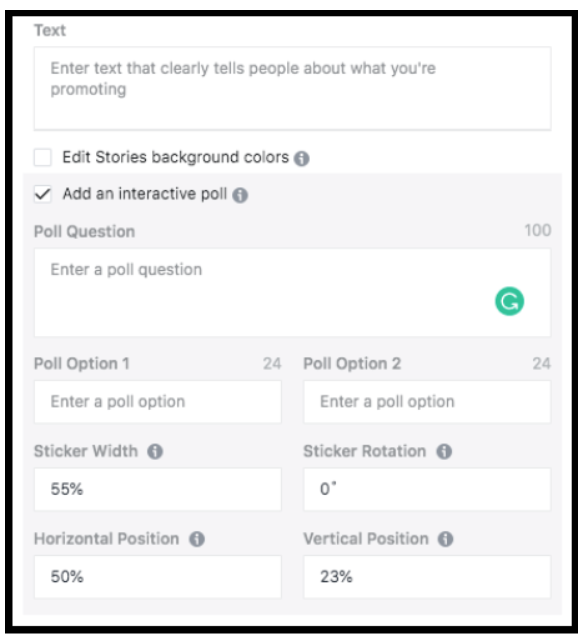
- Power 5. This last strategy corresponds to five crucial pillars to improve your campaign performance. These pillars are the following:
- Campaign budget automatization.
- Simplified account structure.
- Automatic placements.
- Dynamic Ads / Dynamic Creative
- Auto Advanced Matching.
- Hire a Professional Marketing Agency
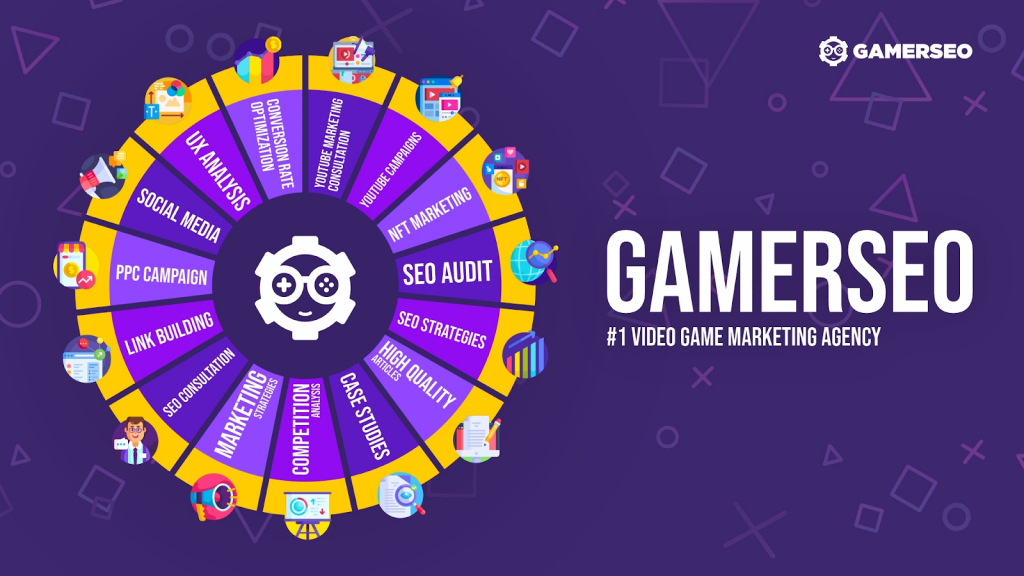
Selecting the right ad level or the target people who will show interest in your product is difficult. We know this. For this reason, the team behind GamerSEO has reached a deep level of knowledge in Facebook ads, offering the best services regarding advertising campaigns, creating the proper ad set, and optimizing your Meta advertisements.
Working with marketing experts is one of the main strategies to avoid common ad mistakes, such as ad fatigue, the ad placements you don’t leverage, a wrong design for your creatives, etcetera. Working with seasoned professionals lets you manage better auto-optimization rules and break the Facebook algorithm to reach your desired goals.
Indeed, GamerSEO experts’ knowledge will be the key to optimizing your Facebook advertisements, obtaining a higher click-through rate, and increasing the conversion rate. Please message us through our contact form to answer all your questions.
The Bottom Line
Nowadays, Facebook – Meta – and all its associated social media represent a big part of the social media business. Leveraging the huge number of users is crucial for the success of your business related to advertising campaigns. Adopting the strategies we shared above will help you optimize Facebook ads, improve the ad copy, and get more revenue in the long term, which is the final goal.

A PPC specialist who started with organic social media. For several years, the core of his activities are:- Google Ads, Microsoft Ads, Meta Ads, TikTok Ads, Twitter Ads, Linkedin Ads. He has led campaigns with a global reach, e.g. for FootballTeam, G2A, ETOTO, as well as many smaller campaigns in the sports, construction and financial industries. Has full focus on ROAS. Privately, a fan of football, history of wars and Star Wars.

